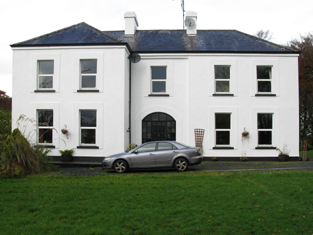Errit Lodge
Houses within 10km of this house
Displaying 13 houses.
Houses within 10km of Errit Lodge
Displaying 13 houses.
| House name | Description | |
|---|---|---|
| Mannin | The harper, Turlough O'Carolan, was a regular visitor to Mannin House and composed a number of tunes in honour of the Dillons and Betaghs. At the time of Griffith's Valuation the townland was owned by Margaret Mary "Beatty" and included a house valued at £5. The house still exists but is not inhabited. It was owned by a Mr Grogan in the 1940s. |

|
| Tavraun House | A home of the O'Grady family in the 19th century, this house is still lived in and well maintained. In 1944 the Irish Tourist Association surveyor recorded Tavraun House as a plain, two-storey house, owned by Mr Walsh. Sir Henry Doran of the Congested Districts' Board lived in the house at the beginning of the 20th century. The family vault of the O'Gradys is in Urlaur Abbey. |

|
| Annagh | This townland was in the possession of Thomas Tyrle (Tyrrell) at the time of Griffith's Valuation. No house there has a significant valuation. In 1786 Wilson had noted Annagh as the seat of Mr. Dillon. | |
| Carrowbeg | Occupied by Patrick Sweeney in 1814 and by Richard O'Grady at the time of Griffith's Valuation. The house has been renovated and modernized and is still inhabited. |

|
| Loughglynn | Loughglynn was the main residence of the Dillon family, built circa 1715, extended in the 1820s and altered again in the early 20th century. It is recorded in 1814, 1837 and in Griffith's Valuation as the seat of Viscount Dillon. The Dillons were absentee landlords for much of the nineteenth century and their agents, the Stricklands, lived in the house. During the twentiethcentury the house served as a convent. Loughglinn House is still extant. |

|
| Caher | Charles French was leasing the house at Caher, barony of Frenchpark, valued at £16, from Lord de Freyne's estate, at the time of Griffith's Valuation. Lewis also records the house as the residence of C. French in 1837. In the same year the Ordnance Survey Name books record Caher as a "dwelling house of three stories and slated". In the 1749 Census of Elphin F. Elwood was recorded as residing at Caher. By 1894 it was the residence of the Dowager Lady de Freyne. The building is still extant. | |
| Coolagarry | Charles Ellison was leasing a property at Coolagarry valued at £8 10s from Viscount Dillon's estate at the time of Griffith's Valuation. The Ordnance Survey Field Name books record that there were no houses that could be called farmhouses in this townland in 1837 so it is assumed that Coolagarry must have been constructed 1837-1855. There is still a house extant at this site. |

|
| Glebe West | The Rev. Harlow Fleming was occupying the house valued at £6,at Glebe West, barony of Frenchpark, at the time of Griffith's Valuation. It was church property, being leased from the Bishop of Elphin. The house is still extant and apparently occupied. |

|
| Ballinlough | Rev. Robert Blundell was leasing a property valued at £16 at Ballinlough, parish of Kiltullagh, from the Sandford estate at the time of Griffith's Valuation. This appear to be the Glebe House. It is now a ruin. | |
| Willsborough | Henry Sampy was leasing a property valued at £3 10s + 155 acres at Willsborough, barony of Castlereagh, from the Sandford estate at the time of Griffith's Valuation. In 1814 this property was the residence of Walter Jordan. The site of Willsborough House is now occupied by the Community Centre and pitches of Michael Glaveys GAA Club. A memorial stone for a dog owned by Helen Sampey is preserved against the wall of the building. |

|
| Cashlieve House | Lewis describes a house at Cashla in the parish of Kiltullagh as a sporting lodge belonging to W.R. Wills in 1837. In the 1850s William Sandford owned a property valued at £24 at Cashlieve, barony of Castlereagh. The house now known as Cashlieve House was built in the later nineteenth century. |

|
| Derry Lodge | At the time of Griffith's Valuation, Elizabeth Sandford was leasing a house at Derry, barony of Frenchpark, valued at £6 from the French estate. The house is described in the Ordnance Survey Name books of 1837 as "a good house, two stories high and thatched". The first edition of the Ordnance Survey map indicates a mill and a building described as "site of old iron works" close to the site. A modern building is located at Derry now. | |
| Dunmore Lodge | Melvin states that the Dunmore estate had been inherited by the Gores in the early eighteenth century and that Ralph Gore resided at Dunmore during that century. His mansion was subsequently in use as a barracks until it was destroyed during the Civil War in the early twentieth century. Marked on the Taylor and Skinner map of 1778 as the residence of the Earl of Ross and also noted as "the fine seat of the Earl of Ross" by Wilson in 1786. In 1814 Leet noted "Dunmore Lodge" as the residence of John Egan. |

